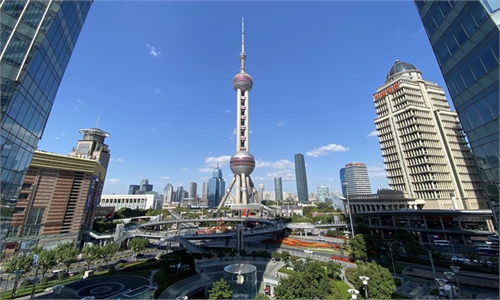
A view of Shenzhen, a tech and innovation hub in South China's Guangdong Province Photo: VCG
As the competition between China and the US in the global industrial chain reaches white hot levels, people often talked about the regionalization or localization of supply chains, a topic often raised together with supply chain diversification. These are the reactions of supply chains to geopolitical tensions, but also to some of the recent global shocks like the pandemic and the outbreak of conflict in parts of the world.To some extent, localization and the diversification of the global supply chain is inevitable, but it will be slow and structural. Some industries will be relocated, but some will not. It will depend on the characteristic of the industry, the comparative unit cost, land cost, and how sensitive any given supply chain is to global shocks.
During the pandemic, we saw how supply chain problems affected consumer markets, leaving poorer people particularly vulnerable. The global community must now work together, to collaborate on the safeguarding of the global value chain and global supply chain. We need collaboration that does not politicize the global value chain coordination, and does not overlap with military or defense related activities.
Some US politicians believe the US should "decouple" from China by reducing its dependence on Chinese products and supply chains and also cut the US-China scientific re-search cooperation in some sectors - for both so-called economic and national security reasons, but even a partial decoupling is no good for the two countries, and may have a negative impact on the global economy.
It could be unfair for some countries because they are forced to choose what kind of technology system they have to use or adopt. This will cost a lot financially, and will narrow their opportunities at the same time, because if you choose one technology system or take sides, then you close your door to the other side and cannot benefit from it.
Secondly, innovation in our time is an increasingly collaborative undertaking. Global research and development is very much connected even in the US. Nearly half of its high-quality research comes from international collaboration, and in Europe more than half of its high-quality research comes from international collaboration. So cutting the links and collaboration with China and the countries which will work with China, means that they are cutting the talent and resources, narrowing their markets and also reducing their diversity. All these outcomes will be harmful to innovation in all countries.
In recent years, China's scientific and technological industry underwent significant changes. Firstly, in terms of science and technology and innovations, China has made significant progress since 2006, especially over the last 10 years. WIPO publishes the global innovation index every year and China has jumped from number 34 in 2012 to number 11 in 2022.
Secondly, China has become the world's second ranked country in terms of R&D expenditure, only behind that of the US.
Thirdly, China has made breakthroughs in some scientific areas and industries, such as digital economy, artificial intelligence, aerospace technology, deep sea exploration and some renewable energies.
The Chinese government has, over the years, developed an innovation strategy which suits the country and also enables the country to grow faster and catch up with other world's leading innovation countries. This is what I call an open national innovation strategy.
What makes China's open national innovation system unique is that it is built on two drivers - the open market and the state - and also uses the resources and also benefits from the two markets, the domestic and international market.
Following China's opening-up, the resulting activities carried out through trade and foreign direct investment, and also through people's movement, help the knowledge exchange between China and the international innovation system and the global economy, enabling the country to grow rapidly and catch up with the leaders in innovation. That's why China's innovation system works faster than a closed, single driver innovation system. Some have overemphasized a view that China is a state capital-owned economy and the state is the sole engine of innovation, which is not true. In China, the private sector and the multinationals also play a very important role.
China still has many areas in science and technology innovation that it needs to develop and catch up. The current innovation system and the policy is still evolving and is not yet perfect, but the overall framework is superior and more advantageous than a traditional closed door, single driver innovation system. This is demonstrated in China's progress, also reflected in the revival of industrial policy in the US and Europe.
Openness is mutually beneficial to all parties. It engenders trade creation, and also investment, following FTAs. It will also lead to income creation, income growth, and create more jobs. Therefore, China's development in pursuing more or global oriented networks for trade and investment, and also signing more FTAs, will not only benefit China, but will also benefit other countries. I think China has played a very important leading role to support international trade, to support trade and globalization.
The article was compiled based on an interview with Fu Xiaolan, founding director of the Technology and Management Centre for Development at Oxford University and Fellow of British Academy of Social Sciences.



